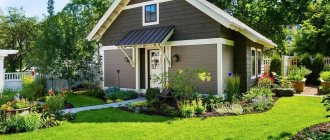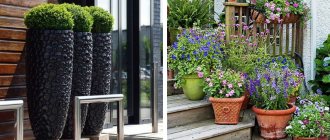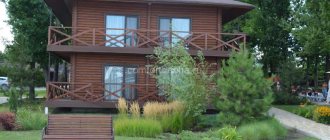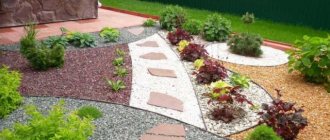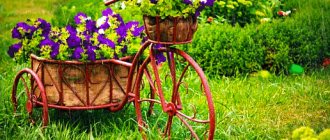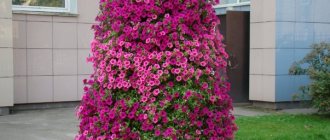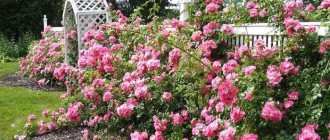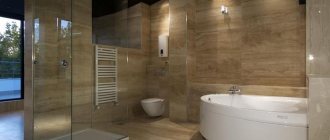It’s rare that a summer cottage, and even more so a garden, does without flower beds. Flowers give us considerable aesthetic pleasure; they delight us with their presence and, attracting our eyes, make us admire them. That is why flowers are permanent residents of garden plots. And they are grown, as a rule, not chaotically, but in flower beds, in beautifully decorated flower beds. At the same time, they are selected according to color, crop varieties and many other factors. And to make flower beds from annuals, the diagrams of which you will find in the article, yourself, you do not need to have the skills of a landscape designer. The main thing is that everything is correct
Rules for creating flower beds
Before you start creating a flower garden on your site, you should familiarize yourself with the basic rules for carrying out the work. They will make it easier to understand the process of arranging flower beds and will allow you to do them not only quickly, but also in the best possible way.
- Never rush. This rule is especially relevant for newcomers to the world of gardening who recently bought a cottage or garden. The fact is that in one season you are unlikely to have time to qualitatively and beautifully arrange all the planned territories. It is best to tackle the most important problems at the beginning of developing a dacha plot and at the same time equip a small, modest flowerbed. Over time, you will be able to cover other areas and plant them with flowers selected according to the color scheme and characteristics of the growing season.
Design of a flower bed of annual flowers
- Before you go to the store for seeds, think about what you want your flower garden to look like. Remember that only a flowerbed that meets all your wishes can become a source of pride, which should first be reflected on paper in the form of a diagram.
- In accordance with the scheme and climatic conditions, select annual flowers that will perfectly match in color and requirements for growing conditions. But beginners should not immediately get involved with capricious cultures. It’s better to start by practicing creating flower beds from unpretentious varieties.
- Remember that the foundation of a flower bed is the plants that cover the soil. They will cover not only the brown soil, but also the stems of taller flowers. In addition, they are excellent soil protectors from moisture evaporation and growing weeds.
- You shouldn’t plant plants one at a time – they always look much better in groups. But too many crops are bad, as it will be inconvenient for them to grow.
- When drawing up a diagram, remember that any flower garden should have its own zest. This could be some kind of central decorative bush, beautifully arranged perennials, annuals that are somehow different from the bulk of the flowers surrounding them and stand out against their background.
Flower garden schemes
Raised bed of petunias and lobelias
Flowerbeds of annuals photo
On a note! Despite the fact that many gardeners choose perennial crops to create flower beds, annuals also do not go out of fashion. They are often unpretentious, easy to grow, and allow you to create completely new and unique compositions every year. In addition, they are very beautiful and bloom with rich, bright flowers, which is their main advantage.
Beautiful flower bed with petunias
How to make your yard greener
Already, citizens are sending applications to the Department of Natural Resources Management and Environmental Protection to plant landscaping in their yards next year. Every year more and more Muscovites participate in choosing yards and plant species for the campaign. About 80 percent of the yards were landscaped based on the results of a vote by “active citizens.”
The procedure has become simpler: residents simply submit an application, specialists inspect and evaluate the yard, and a decision is made within two weeks. The application can be sent to the website of the government, the Department or to the Active Citizen portal. They are accepted in the fall until September 10, in the spring until March 10.
An application can be made for one yard area. The Department of Natural Resources coordinates the planting scheme for a specific address with the State Unitary Enterprise Mosgorgeotrest. If the plants chosen by residents cannot be planted, experts will make changes to the scheme. After approval of the application, the Department will purchase seedlings, its employees will provide equipment and help with planting.
A list of yards and a planting schedule are published on the Department’s website. For more information on how to landscape your yard, how many trees and shrubs can be planted in it, and where to complain about poor-quality planting, see the “City Councilor” section.
Rules for choosing planting material and location
One of the first tasks of a gardener when arranging a flower bed is choosing its location. The flowering period will largely depend on this. The place where the flower bed is located should be well lit. It is also worth thinking about the convenience of watering - flowers need regular supplies of water. You should not place the flowerbed behind the house away from a barrel of water or an irrigation system. It makes no sense to plant a flowerbed where no one will see it - flowers were created by nature in order to admire them. So let the flowerbed be in a visible place - at the exit from the house or outside the window, at the entrance to the house.
Flowers should be placed in a visible place
A few more words about the choice of planting material. Be sure to consider color, flowering period, and height. Any flower bed should bloom for as long as possible, and the correct selection of flowers according to their flowering time will help prolong the flower beauty - that is, when the flowering period of some ends, others will replace them.
Number seven 7 made from flowers
Flower beds can be different in shape and height. And each type has its own unwritten design rules. For example, when creating three-tiered flower beds, the tallest plants should be located in the center or in the background. Along the edges there will be lower crops, which will act as a kind of frame. Between these two tiers there will be a second one, which sets the main background for the flower garden.
Amaranth, fragrant tobacco or other plants that bloom all summer are planted in the center of the flower beds.
The number of flowers is calculated approximately like this: central flowers - several pieces or a small patch of fairly tall plants. Crops with an average height are planted in quantities twice as large as the main ones. And the shortest ones will have a population three times greater than that of the main flowers.
DIY mill for the garden
The main function of such a structure is, of course, decorative - a mill on the site pleases the eye and creates an atmosphere of comfort. It is also used to decorate gardens and flower beds in the Old Russian or European style (depending on the appearance of the object itself). Read this article for more details.
It is best not to take more than 3 types of flowers and not create complex compositions when arranging your first flowerbed. In this case, care will be simple and pleasant.
Making a flower bed
Annual plants
Among the annuals, sweet peas , marigolds , snapdragons , nasturtiums , zinnias , salvias , and sweet tobacco are .
cosmos , mallow , malopa , lavatera , ursinia , and decorative beans bloom . But they will bloom throughout September.
Marigold
Marigolds, Tagetes, marigolds, caps are synonymous names of annual plants of the genus Tagetes of the Asteraceae family. They come from North America.
Marigolds are the most unpretentious flowers for a flower bed, the best plants for beginners
Their advantages are obvious:
- good germination and fast growth. It can be grown through seedlings in the second half of March - early April, as well as by direct sowing of seeds in May (dates for the middle zone);
- unpretentiousness - grows in the sun and in light shade, can tolerate heat and drought, is undemanding to soil, but prefers light, fertile ones;
- Decorative – characterized by constant, abundant flowering from June until frost, the main thing is to periodically pick off wilted inflorescences.
Yes, marigolds have been grown for a long time, but not everyone likes their specific smell, and many gardeners are already fed up with them. In this case, we suggest paying attention to the new products that appear every year.
The amazing variety “Fantastika” with its inflorescences resembles large-flowered chrysanthemums
American breeders have developed a variety of rejected marigolds , “Strawberry Blonde,” which is a “chameleon”: a whole palette of shades blooms on one plant over the course of a season – from raspberry-brown, carmine-pink to orange-golden and pale yellow.
“Strawberry blonde” grows up to 25-30 cm, the diameter of the inflorescences is 6 cm
Marigolds look good in joint plantings with other annuals. If you select compositions by color, you can get original combinations that highlight the beauty of all participants.
A harmonious duet of warm yellow-orange with delicate lilac-blue - marigolds plus ageratum
Gardeners grow three types of marigolds : erect, deflected, thin-leaved. We have combined information about them into a table:
| View | Characteristics: habit (appearance), height | Varieties and hybrids |
| Erect (African) | Strong plants forming a bush of straight stems. Medium- and tall-growing ones reach from 40 to 120 cm in height. Distinguished by large double inflorescences | Orange – “Hawaii”, “Orange”, “Orange Knight”, lemon yellow – “Burke Lemon”, “Lemon Prince”, “Lemon Giant”, yellow – “Antigua Gold”, “Yellow Stone”, “Supra F1” , white and cream - “Eskimo”, “Kilimanjaro”. Undersized : "Cupid", "Snow Storm", "Golden Age" |
| Rejected (French) | Low-growing plants, reaching 15-40 cm. Inflorescences of medium size, simple, semi-double, double | Clove-shaped (reed petals) - “Rumba”, “Monetta”, “Tango”, “Cross of Honor”; chrysanthemum-shaped (tubular petals) - “Bonita”, “Bolero”, “Carmen”; anemone-shaped (tubular flowers in the middle, ligulate along the edges) - “Tiger Eyes”, “Spray Petite”, “Mackenna’s Gold” |
| Thin-leaved (Mexican) | Low, up to 20 cm, densely leafy (small, highly indented leaves), with many small simple flowers | “Karina orange”, “Lemon gem”, “Paprika”, “Ursula golden yellow”, “Starfire” |
Levkoy
Levkoy gray or matthiola is a beautiful plant of the Brassica family. It has a straight, slightly pubescent stem, lanceolate, fleecy or smooth leaves. The flowers are large, simple or double, white, yellow, pink, purple, lilac, violet, collected in dense racemes. The culture is light-loving, prefers light, moderately fertile and moist soils. Tolerates slight cold.
Levkoy is perfect for cutting, can stand in water for up to two weeks
Among the levkoys there are shrub and dwarf forms. Almost all of them emit a pleasant aroma during the flowering period.
Levkoy long-petaled is better known as matthiola bicornuata (Night Beauty), valued for its characteristic violet aroma, intensifying in the evenings.
Multifloral bean
For vertical gardening of fences, gazebos, verandas, arches, climbing plants are used, for example, decorative beans, which belong to the Legume family. Its smooth herbaceous stems grow up to 4 m long. The leaves are dark green, imparipinnate. The flowers are medium-sized, white, red or red-white. Beans grow better in lighted areas. Its large seeds (beans) are planted in early May immediately in a permanent place. In order for the plants to produce good foliage and many flowers, you need to adhere to the correct agricultural techniques: carry out regular fertilizing, abundant watering, and mulch the soil.
Red “Duchess” with a combined color is one of the highly decorative varieties
It is better to grow annuals through seedlings - this will allow you to quickly get a flowering flower bed. The exceptions are nasturtium, eschscholzia, beans, poppy seeds, lupine, whose sensitive root system does not like replanting. They are grown by direct sowing.
Annual seedlings should be planted in a permanent location when the threat of return spring frosts has passed.
For lush, continuous flowering, it is necessary to remove faded flowers and inflorescences. Many species require pinching the tops and pruning to stimulate the formation of side shoots with new flower stalks.
Types of flower beds
Flowerbeds can have completely different shapes and sizes - it all depends on your wishes and capabilities. They are round and square, figured, triangular.
Flowerbed shapes
There are three main ways to form flower beds.
- Uniform carpet . Typically, this type uses plants of only one species or similar in size but with different petal colors. Such a flowerbed is easy to care for, and it looks very impressive.
- Multi-tiered flower bed . It is created by combining flowers of different heights, but the lowest crops will always be in front. It can be round, corner, wall. Such plantings are more difficult to maintain.
- Flower borders . These are flower beds created along garden paths. They are unpretentious and are usually created from one or two types of plants.
Blooming paradise in your favorite garden
There are also very unusual flower beds that can complement any elements of a summer cottage - for example, decorate the area around a pond, or have the shape of an animal.
An example of an original flowerbed in the shape of a pig
Choosing colors
An important aspect when drawing up a flower bed scheme is the color of plant buds. At the initial stage, it is better to use only 2-3 contrasting shades, and later move on to more complex color transitions and combinations. But even a beginner should understand that color has a significant impact on a person’s psycho-emotional state, so you should choose plants that produce flowers with the shade of petals that you like.
Choosing colors for a garden flowerbed
Table. Colors and their influence on humans.
| Color | Characteristic |
| Yellow | It is usually preferred by joyful and active people; it is the color of a good mood. And it will give confidence to a shy person. In the garden, this color will be given by lilies, marigolds, calendula, snapdragons, daylilies, cinquefoil, and rudebeckia. |
| Pink | Improves mood, relieves sad thoughts. Meadowsweet, cosmos, petunia, carnation, daisy will give this color in the flowerbed. |
| Blue | Calms, comforts, relieves stress. Iris, lavender, forget-me-not, delphinium - flowers with blue petals. |
| Red | The color of energy, strength, optimism, passion. Carnation, primrose, rhododendron will give it to you. |
| Violet | A color that improves your emotional state and has a positive effect on the functioning of the immune system. These are lilacs, violets, speedwell, pansies, and aster. |
| Orange | A color that gives self-confidence and lifts your spirits. These are chrysanthemum, marigolds, cinquefoil, and gravilate. |
Flowerbed of petunias and marigolds
Yellow flowers for a flower bed
On a note! Variegated flower beds can always be slightly diluted with white flowers. They will add zest to the plantings. And in order to choose colors that combine with each other, use the color wheel.
Green capital
Moscow is one of the greenest cities in the world: more than half of its old territory is occupied by green spaces. This is twice as much as in London, 2.5 times more than in Paris, and 14 times more than in Beijing. How green the capital should be is determined by the building codes and regulations “Urban Planning. Planning and development of urban and rural settlements.” This figure should not be lower than 40 percent.
Greenery not only traps tons of dust, it makes the city more comfortable. Therefore, in Moscow, new trees and shrubs are planted, flower beds and lawns are created. Only under the “My Street” program this year more than two thousand trees will be planted, and in total there will be over 50 thousand. The capital will also be decorated with 800 thousand shrubs.
Selection of types of flowers
Creating a beautiful flower bed is a creative process that can completely absorb any gardener. This is a great way to realize your potential as a creator. By choosing the right plants for your flower beds, you can create a real living work of art on your site.
Making a flower garden from annuals
Scheme of a triangular flower bed
A huge number of seeds of all kinds of flowering plants are now sold on store shelves. Which ones are best suited for creating flower beds? First of all, focus on the growth and flowering period of plants, as well as the color of their petals.
Table. The most popular types of flower plants for flower beds .
| Name | Flowering period | Height, cm |
| Lobelia | June-September | About 15 |
| Ageratum | July-October | 15-70 |
| Iberis | June-October | Up to 40 |
| Marigold | June-September | 15-100 |
| Nasturtium | June-October | Creeping up to 400, bush 50 |
| Petunia | June-mid October | 15-80 |
| Zinnia | June-October | 20-70 |
Also, low-growing annuals include: dwarf begonia, viola, lobularia, dwarf aster; for tall ones: lupine, peony, astilbe.
raised flower bed
Prices for annual seeds
annual seeds
What about in the fall?
This fall, they plan to plant about four thousand trees and 200 thousand shrubs in Moscow courtyards. The list of households will be formed based on the results of voting, which took place on the Active Citizen portal from April 28 to May 28. At the second stage, residents will choose plant species.
Additional landscaping is expected in the areas near 160 social facilities: it is planned to plant 850 trees and 30 thousand shrubs. About three thousand trees and 20 thousand shrubs will be planted in place of those lost under the Hole to Hole program.
Flower schemes
To make it easier to navigate when creating your own scheme, we suggest that you familiarize yourself with several simple but beautiful ready-made options.
Table. Flower bed schemes.
| Scheme, photo | Description |
Scheme No. 1 | 1 – annual stock roses of three colors (white, red, yellow); 2 – decorative sunflower; 3 – Spanish poppy; 5 – cardinal lobelia; 6, 7, 8 – bell, catnip; 10 – sedum. The remaining flowers can be selected in accordance with the color indicated in the diagram. |
Scheme No. 2 | Flowerbed cake: 1 – low red flowers; 2 – white or silver flowers; 3 – medium-sized plants with red flowers; 4 and 5 – high background crops. |
Scheme No. 3 | Round flowerbed: 1 – cannas; 2 – begonia; 3 – petunia; 4 – snapdragon; 5 – marigolds; 6 – alyssum; 7 – ageratum; 8 – pyrethrum. |
Scheme No. 4 | 1 – amaranth; 2 – zinnia; 3 – garden quinoa; 4 – chard; 5 – basil; 6 – nasturtium. |
Scheme of a flower bed of shade-tolerant annuals
Planting flowers by sector
Scheme of a round flower bed of tulips, daffodils, hyacinths, scilla and mouse hyacinth
Flowerbed of bulbous plants - diagram
We create a flower garden with our own hands
Let's look at the creation of a flower bed step by step using the example of such a wonderful flowering corner.
DIY flowerbed
Step 1. Create an exact diagram of the future flower garden in accordance with your capabilities and wishes. Don’t just try to design large flower beds - it’s better to make one small and neat than a large one that you won’t have enough strength for. The best option to start with is a flower bed with 25-30 plants.
Step 2. Choose a sunny place on your summer cottage. Step back about 1 m from the fence. To prevent the sun from damaging the plants, place the flower bed on the eastern side of the fence or buildings. Mark the border of the flower bed.
Choosing a suitable location on the site
Step 3. Remove all debris from the site, dig up the soil, and apply fertilizer if necessary. Weed out all the weeds.
Digging the soil
Step 4. Level the surface of the soil, break up the earthen clods.
Leveling the soil
Step 5. Purchase flower seedlings or use ones you grew. Plant tall crops in the far corner, then medium-sized crops, and place low-growing crops along the edge of the flowerbed. In this case, holes for all flowers can be dug in advance.
Planting flower seedlings
On a note! Be sure to consider the size of an adult plant when planting. It is important that over time the flowers do not press on each other, but there are no large gaps between them.
Step 6. Take good care of the flowerbed - regularly water the flowers, remove wilted ones, fertilize.
Watering flowers
This way you can arrange a corner flowerbed on your site. With a round one you will have to work harder. The fact is that its edges must form a perfectly smooth circle, otherwise it will appear crooked. But achieving an excellent result is quite simple: a stick is dug into the center of the flower bed, and a rope equal to the radius of the flower bed is tied to it. Moving the rope in a circle, outline the boundaries of the flowerbed with sand. And so that the plants “fall” into place, you can make a preliminary sketch inside the circle with sand, outlining where the holes for each flower will be marked.
Begonia everblooming in a flowerbed
Gardeners whose plots do not allow them to set up a whole garden can get out of the situation by creating flower borders along the edges of the paths. They look very beautiful, especially if they are made from flowers of the same type.
Workbed of several types of plants
Work in landscape design
And finally, some tips for arranging flower beds.
- Do not forget to leave gaps of about 10-15 cm between plants planted in the ground. This is necessary for optimal development of crops.
- Do not place the flower garden in a low area, especially if it rains often in your region. Otherwise, the soil under the flowerbed will be too damp and the flowers will begin to hurt.
Scheme for creating a round flower bed
Gravel garden - well-groomed flower beds without constant worries
Do-it-yourself vertical flower beds - a magnificent decoration for a summer house
Creating a flower garden with your own hands, following the diagram, is not so difficult, and you have seen this personally. The main thing is not to rush and think through everything carefully, then planting will definitely go like clockwork, and you will enjoy the beautiful flower beds in your garden all summer.
Video - Continuous flowering beds of annuals
Capital record holders
The most greenery appeared this spring in the southwest of Moscow. In the South-Western Administrative District, 1,356 trees and about 42.5 thousand shrubs were planted, and the record holder was the courtyard of house 6b on Ratnaya Street, where 71 junipers appeared in honor of the anniversary of the Victory. 760 trees and almost 21 thousand shrubs “grew” in the Western District, and in the South-Eastern District - 753 and about 23.5 thousand, respectively.
The north of the city was decorated with 515 new trees and almost 19.5 thousand shrubs. The most plants were planted near house 26, building 1 on the street of the 800th anniversary of Moscow: 30 rowan trees, larches and maples and 200 dogwood and lilac bushes. There are 429 trees and more than 17 thousand shrubs in the Eastern Administrative District. The greenest were the courtyards of houses 29 and 33 on Lukhmanovskaya Street: 32 maples, rowan trees and willows and 1092 cotoneaster bushes, lilacs, caraganas and spirea.
In total, 59,268 trees and 1,311,906 shrubs have been planted in Moscow since the beginning of the campaign.
